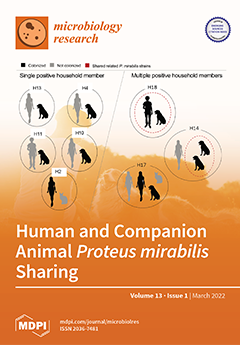This study aimed to evaluate the effectiveness of
A. oryzae in inhibiting aflatoxin B
1 (AFB
1) and ochratoxin A (OTA) production by
A. flavus and
A. carbonarius, respectively, under shifting temperatures.
A. oryzae was tested on different agar, namely coconut cream
[...] Read more.
This study aimed to evaluate the effectiveness of
A. oryzae in inhibiting aflatoxin B
1 (AFB
1) and ochratoxin A (OTA) production by
A. flavus and
A. carbonarius, respectively, under shifting temperatures.
A. oryzae was tested on different agar, namely coconut cream agar (CCA) and chili-based agar to figure out the variation in the effectiveness of
A. oryzae on the most appropriate medium for
A. flavus and
A. carbonarius to produce mycotoxin and under natural condition where they are predominantly found. On CCA, the temperatures applied were 20, 30, 35, 40, 20/30, 20/35, and 20/40 °C, while on chili-based agar, the temperatures imposed were 20, 40, and 20/40 °C, at varied water activity of 0.92 and 0.97
aw. The findings indicated that
A. oryzae was much more effective in inhibiting the growth of
A. flavus rather than
A. carbonarius, yet it was able to inhibit higher OTA concentration than AFB
1 at fluctuating temperatures on CCA as the most appropriate medium for
A. flavus and
A. carbonarius.
A. oryzae effectively inhibited AFB
1 and OTA at static temperature of 20 °C and water activity of 0.97
aw on chili-based agar. Under fluctuating temperatures (20/40 °C),
A. oryzae was also able to control mycotoxin, particularly OTA at high water activity (0.97
aw).
Full article





